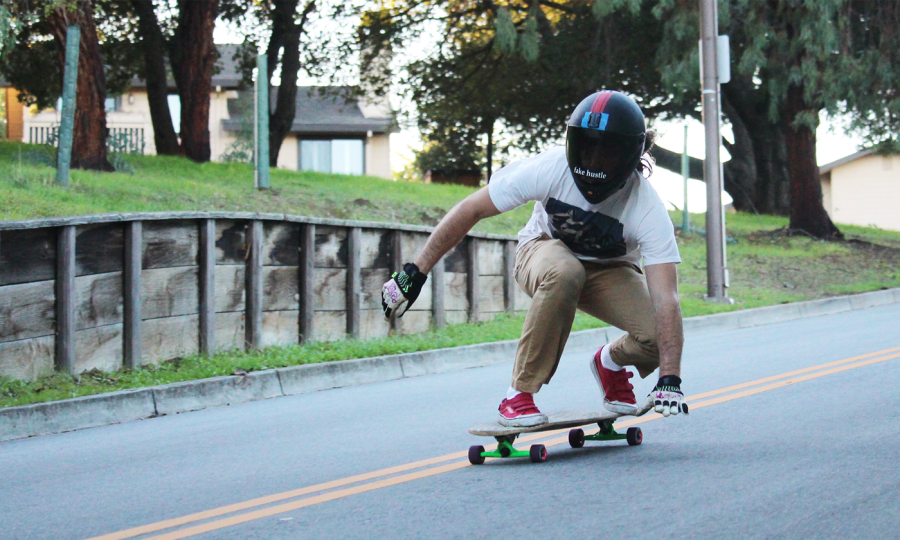Longboarder Cruises as King of the Hill
A lone figure standing on a plank of wood races down the side of the road at nearly 55 miles per hour. He crouches to the ground, the wind whipping his shirt back and places a gloved hand against the pavement. Suddenly, the board twists sideways and the hand screeches across the road filling the air with the smell of burnt rubber. The rider calmly completes the turn and cruises to the stop at the end of the road. The skater is Brett McBride, a sophomore at Palo Alto High School who practices the unique and daunting sport of downhill longboarding.
“[Downhill longboarding] is just when you pick the best line [down], bomb hills and try to go fast.”
Brett McBride, sophomore and downhill longboarder
Since June of last year, McBride has competed in countless races, and has finished in the top three in every competition except one. His skating prowess caught the attention of a company called Five Mile, a skateboard manufacturer that sponsors talented skaters to test boards and compete as a team.
Competitive downhill longboarding is similar to slalom skiing without the gates. A skater races to the bottom of the hill as quickly as he or she can without falling. In doing so, riders can achieve speeds between 40 to 80 miles per hour. Since the wheels lose traction if a normal turn is attempted, McBride has to perform complex slides, turns and tricks to avoid smashing into walls or falling off the edge of a hill.
“[Last year] I went to a skate competition and there was a staff writer from Five Mile there who said he could get me a free board,” McBride said. “When I Facebook messaged him later, he was like ‘You’re on the team’.”
Through his sponsorship at Five Mile, Brett’s talent was quickly recognized by other companies. From this recognition, he has been able to learn from pro skaters that were also on the team. After only a year of being a team rider for Five Mile, McBride was recognized by Peninsula Downhill Crew as a team rider and was sponsored by Orangatang Wheels and Black Diamond Sports.
Being a team rider means that McBride has to represent the company in competitions, consistently win and test new gear to report its effectiveness to the company. McBride is occasionally filmed for movies intended to market a certain product.
Lastly, being a team rider means getting a lot of perks. These perks can be anything from a new sticker to an experimental team board to a pre-paid trip to a competition on the East Coast.
McBride has been skateboarding for as long as he can remember, but he began transitioning into downhill longboarding in fifth grade.
“There was this event that came nearby and there was this dude just flying down a hill one footed and then did a fat powerslide. I was like ‘I gotta start doing that’ and in seventh grade I did.”

He bought a longboard and taught himself the necessary techniques through a series of YouTube videos. After four years of learning, practicing and a decent number of falls, McBride gradually became an expert in downhill longboarding.
The equipment required for downhill longboarding is fairly simple. McBride usually wears a rounded helmet and gloves with low-friction pucks attached to the palms so that he can put them on the ground and make slides. The board is comprised of a stiff plywood deck about forty inches long. Large rubber wheels are attached to the deck via front and rear axle mechanisms called trucks. In competitions, McBride will wear a leather suit that reduces wind drag. Though simple, each piece of equipment must perform as expected or great injury or death could occur.
To master the turns and tricks needed for downhill longboarding, constant practice is needed. In the past, McBride has struggled with balancing skating time and school work but has now found a system that works with his schedule.
“I practice every weekend and over the summer; it’s an everyday thing,” McBride said. Lately I’ve had to put it off because for some reason I play soccer.”
Ultimately, McBride spends most of his weekdays focusing on school, but longboarding dominates all of his free time.
Unfortunately, traveling at speeds often over 40 miles per hour and dangerously swerving to avoid cars often results in injury. In addition, poor road conditions or even the mistakes of other skaters can cause catastrophic crashes. Over the years Brett has torn ligaments in his leg, received countless gashes on his arms and torso, sustained an impact on the shoulder that nearly required surgery, broken a wrist and sprained his neck. All of which McBride brushes off as simply part of the sport.
In the future, McBride hopes to travel the world through sponsor money and hone his skills on more difficult hills. He plans to continue longboarding after high school and center his life around it.
“This summer I’m planning to go to Washington, but after high school I want to go to South America and Europe,” McBride said. “If I manage to hold my sponsors, I’m free to go wherever once I turn 18.”
McBride has had great success in his sport and will continue to compete, but the main reason he continues to longboard is because he is passionate. He will always love the rush associated with the sport, and has from a young age.
“When I was little I skateboarded down a sidewalk and it was awesome,” McBride said. “The wind, and everything in the moment.”
Your donation will support the student journalists of Palo Alto High School's newspaper



